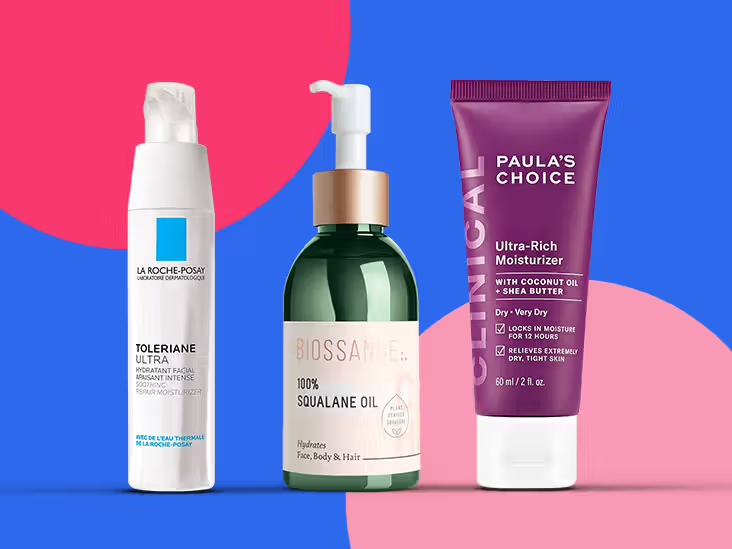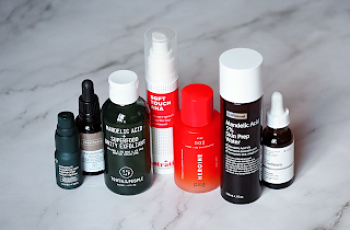What is Squalene? And what are its benefits for skin care?
If you look at the ingredients in your skin care products, you might find both squalane and squalene in them. Yes, they may sound like the same ingredient, and technically they are, but believe it or not, one letter has a big impact on where you find it and how you use it.
Trust me, it’s going to get a lot more confusing before it all makes sense! But don’t panic, let’s learn more about this wonderfully moisturizing molecule.
What is the difference between squalene and squalane?
Squalene occurs naturally in the body and helps the skin look younger, softer, and more hydrated. Just like everything else produced in the body, it starts to deteriorate as we age, and the body is no longer able to keep the skin barrier’s moisture at the right level, leading to fine lines, wrinkles, and other issues.
Applying squalene to your skin should solve this problem. However, as effective as squalene may be, it’s not very stable and can’t be mixed into skin care product formulas unless it’s hydrogenated and processed into squalane, a stable form of the molecule. That’s why you’ll find that the powerful emollient in skin care products is actually squalane. The simplest way to think about it is this: Squalene and Squalane are twins, both are great, but Squalene will keep you clubbing until 6am because you have to work the next day, whereas the other Squalane gets the job done at a reasonable hour.
While you get the skincare benefits of a moisturiser rich in Squalane, there is a downside to this moisturising ingredient: a few years ago, it was discovered that shark livers (yes, sharks, found in the sea) were rich in Squalene so it was thought that the emollient was used in skincare. In recent years, it has become harder to find products containing Squalene in the UK, instead Squalene derivatives are made from olives, rice bran and sugar cane.
Quick facts about Squalene:
Occurs naturally in the body
Moisturise skin, but effectiveness decreases after age 30
Found in shark livers, formerly used to make skincare products
Today, natural sources such as rice germ, olives and sugar cane are used as additives in skincare products
Very unstable and cannot be mixed into skincare formulas
Squalene must go through a hydrogenation process to become Squalane, which is then added to skincare products
What does Squalene do for your skin?
Squalene is the ultimate moisturizer, helping your skin retain moisture for a healthier, more radiant look. The antioxidant properties also fight any free radicals that could alter the appearance, texture, and function of your skin. Using squalane products like serums and moisturizers first can significantly reduce the appearance of sun damage and early signs of aging, such as fine lines, wrinkles, and insufficient collagen production.
Which skin types can use squalene?
You’ll find that all skin types can benefit from introducing squalene into their daily routine. Dry skin will love its extreme hydration, while oily and acne-prone skin will find squalene a great alternative to nourishing facial oils because it’s non-comedogenic, meaning it won’t clog pores or cause breakouts. Even those with rosacea, eczema, and redness will find that the anti-inflammatory properties help soothe and calm their complexion. If you have sensitive skin, you won’t need to worry about this product causing irritation, as it’s unscented and gentle on the skin. However, as with any new product you introduce into your skincare routine (especially if you have sensitive skin), it’s important to be careful and build a tolerance to the product over time.
How to Use Squalene?
You can find hydrogenated squalene (squalane) in many different products, from cleansers to moisturizers. Since squalene doesn’t cause irritation or other skin issues, you can use a wide range of products containing squalene in your daily routine.
However, if you’re worried that this is too much for your skin, your best bet is to opt for a moisturizer or serum, as these products stay on the skin significantly longer and squalene provides moisture to lock in and rejuvenate the skin, giving it a younger, plumper complexion.
Is squalene better than hyaluronic acid?
As a seasoned skincare enthusiast, you may be wondering what the similarities are between squalene and hyaluronic acid and how they can benefit the skin. Hyaluronic acid can penetrate the skin and lock in moisture, but unfortunately it can’t lock in moisture for long-term results. You can find out more about the effects of hyaluronic acid in our blog post about the benefits of hyaluronic acid for skin care.
Squalene’s comparison to hyaluronic acid largely relies on its impressive ability to bind facial moisture and retain it in the skin, giving it enough time to be fully absorbed and infusing the protective barrier with glowing hydration.
What are the dangers of using squalene?
As mentioned before, there are no particular dangers to using squalene in your skin care routine. However, even if your skin has never shown signs of sensitivity before, it’s always a good idea to do a patch test. If there is no irritation or allergic reaction after 24 hours, you can use squalene.
The only real “danger” of using squalene is finding out where the ingredient is sourced from. When buying squalene, always make sure it’s plant-based and not extracted from shark livers, as this is not ethical, sustainable, or environmentally friendly.
This is another fantastic skin care ingredient worth trying. Because it can be incorporated into almost any skin care routine, the hydration will make your skin look younger and healthier. You have to admit, that makes up for the letter confusion of squalane and squalene, right? The results you’ll see will be worth it!
DQH Knowledge drop: In your 20s, your skin cell turnover decreases. (Cell turnover is a key component in keeping your skin youthful.) You know what else slows down? Your collagen production. Starting in your 20s, collagen decreases by about 1 percent per year. Should you want to prevent fine lines and wrinkles, start by eliminating behaviors that contribute to premature aging. “If it’s bad for you, it’s bad for your skin,” says dermatologist Michel Somenek.
“Cigarette smoking reduces blood flow to the skin and causes premature wrinkling and a dull skin texture. Making the repeated pursed motion to inhale can also cause smoker’s lines. Alcohol and recreational drugs are toxins for the skin that damage its cellular structure and DNA,” Somenek tells us. “The faster you eliminate vices while you are young, the better chance your skin and body have to recuperate.” Also, adopting an anti-aging routine in your 20s is key. After all, the best offense is a good defense. We spoke to Somenek and experts Joshua Ross and Audrey Kunin to find out more.
Keep reading for the best anti-aging products for your 20s, according to skincare professionals.
Sunscreen
“We all know that the sun is the number one cause of skin aging and starting the prevention in your 20s is very important,” Ross says. “The majority of your sun damage won’t start to appear until you’re in your 30s, so don’t wait until you see it surface or you’ll be behind the curve. Stay ahead of it with a good-quality zinc-based sunscreen worn daily.”
Farmacy Green Defense Daily Mineral Sunscreen
An invisible sunscreen with SPF 30, plus botanical extracts meant to protect skin with tons of antioxidants. Bonus: It’s clean and fine to use under makeup.
Bareminerals Complexion Rescue™ Tinted Moisturizer Broad Spectrum SPF 30
Although we recommend you use your SPF and moisturizer separately, we also understand moments when you don’t have time or energy for that extra step. For those times, this bareMinerals moisturizer is a great thing to have on hand.
Vitamin C Serum
“A great introduction to anti-aging is to start with a vitamin C serum in your morning skincare routine,” Ross says. “It’s a powerful antioxidant that will neutralize free radicals and brighten the skin.” He adds that it’s a great way to counteract the effects of the sun’s harmful rays, which, as previously mentioned, are among the biggest causes of premature aging.
Drunk Elephant C-Firma™ Vitamin C Day Serum
The Drunk Elephant C-Firma is a lightweight serum that promises to give skin a glow by combining the brightening powers of vitamin C with ferulic acid, l-ascorbic acid, and vitamin E. The included sodium hyaluronate is meant to replace hydration loss, so you shouldn’t have to deal with any irritation.
Sunday Riley C.E.O. Rapid Flash Brightening Serum
This potent serum is jam-packed with vitamin C (15 percent, to be exact), which means it’s a potential superstar at both brightening skin and dousing it in antioxidants.
Peptides
Using peptides on your skin has many benefits, says Somenek. “The skin barrier is what defends the body against pollution, UV rays, bacteria, and toxins. It can be damaged by several everyday factors. Using topical peptides aids in building a stronger barrier,” he says. “Peptides comprise elastic fibers, which are a type of protein. These fibers help to make skin appear taut and firm. Peptides can also help repair damaged skin, relieve inflammation, and even out skin tone. Some peptides can kill acne-causing bacteria that is common in 20-somethings.”
Kunin agrees, saying, “Peptides are an excellent entry point for supporting collagen.” She recommends looking for face and eye treatments that contain these collagen-boosting powerhouses.
Charlotte Tilbury Magic Eye Rescue Cream
This Charlotte Tilbury super-emollient eye cream has a base of coconut oil and shea butter (read: it’s incredibly hydrating). Botanicals plus peptides are meant to help reduce dark circles and boost collagen, respectively.
This creamy moisturizer serves up potent collagen-boosting peptides and pycnogenol, and antioxidant-rich vitamin C. “Instead of sitting on top of the skin, peptides penetrate the outer layer so they go deep. The ‘signals’ they send tell the cells to produce elastin and collagen, which are needed for youthful-looking skin,” explains Somenek.
At-Home Peel Pads
Remember that skin cell turnover fiasco we talked about earlier? One way to help support it is by exfoliating. “Exfoliation is important to help keep skin fresh and luminous,” Kunin says. She recommends using at-home peel pads as an easy and effective way to exfoliate.
“The goal in your 20s is to fight the slowing pace of cell turnover. It is wise to use products that gently exfoliate, yet still remove oil and other impurities. Products that have Alpha Hydroxy Acids (AHA) or Beta Hydroxy Acids (BHA) are a good choice.”
According to Somenek, you should only exfoliate two to three times a week. “People of all ages are guilty of over-exfoliating and that can be too much of a good thing,” he says.
Dermadoctor Kakadu C Intensive Vitamin C Peel Pad
A few swipes of this Derma Doctor powerful peel pad promise to leave your skin glowing and smooth, thanks to the seven (yes, seven) types of chemical exfoliants, including AHA and BHA. It also contains vitamin C via Kakadu plum extract for added brightening and antioxidant protection.
KEY INGREDIENTS Kakadu plum extract is sourced from the Kakadu plum, a fruit grown in northern Australia. It contains vitamin C, which restores the skin’s natural barrier, increases collagen production, and soothes irritation.
Dr. Dennis Gross Skincare Alpha Beta® Universal Daily Peel Pads
These are the gold standard of peel pads, with a cult following and over 900 five-star reviews on Sephora. They’re easy to use and contain a blend of anti-aging exfoliating acids.
Emollient Night Cream
“In your 20s, you need to start upping the hydration in your skincare routine. You may have been cautious of over-moisturizing because of acne in your teens, but as you enter your 20s, your skin transitions and becomes drier,” Ross says. “I recommend an emollient night cream added into your evening skincare regimen.”
“Twenty-somethings need to make sure that they are not using creams that will clog their pores and cause excess oil production,” says Somenek. Opt for non-comedogenic products.
Cerave Skin Renewing Night Cream
One great choice is the CeraVe Skin Renewing Night Cream, which is a non-comedogenic night cream that leaves skin soft and glowy. It combines the moisturizing powers of ceramides and hyaluronic acid.
RoC Retinol Correxion Max Hydration Creme
“The best night cream ingredients contain retinol, benzoyl peroxide, and/or salicylic acid or hyaluronic acid. The goal is to moisturize, yet remove excess oil,” says Somenek. This Roc Retinol Correxion cream fits the bill as it contains both hyaluronic acid and retinol so it promises to moisturize while also being non-comedogenic.



